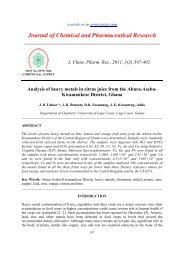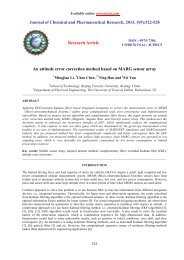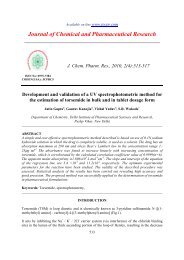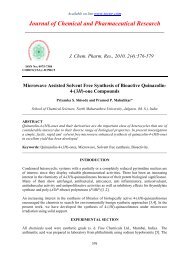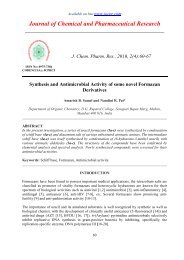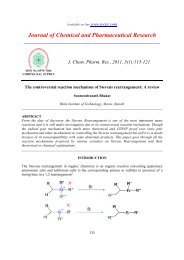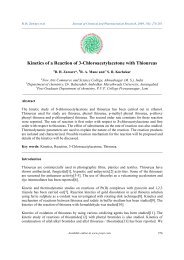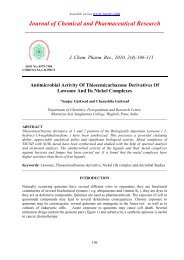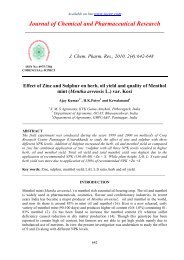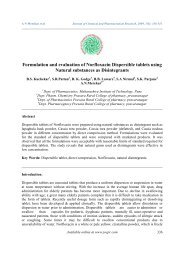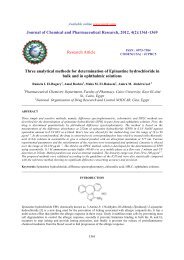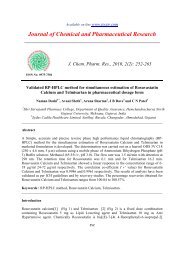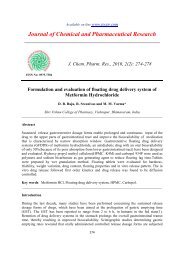EDTA-catalyzed fast and efficient eco-friendly synthesis of ...
EDTA-catalyzed fast and efficient eco-friendly synthesis of ...
EDTA-catalyzed fast and efficient eco-friendly synthesis of ...
You also want an ePaper? Increase the reach of your titles
YUMPU automatically turns print PDFs into web optimized ePapers that Google loves.
Maddela Prabhakar J. Chem. Pharm. Res., 2013, 5(5):89-93______________________________________________________________________________obtained in 85% yield (Table 2, entry 6). The use <strong>of</strong> other catalysts (Table 2, entries 1-5) does not improved theyields even after several hours in water under reflux conditions. However, excellent yield was achieved when thereaction was carried out in presence <strong>of</strong> <strong>EDTA</strong> in water at room temperature <strong>and</strong> the reaction was completed within30 min affording the desired product in 96% yield (Table 2, entry 7).OH+ R CHOO O1 2a-p<strong>EDTA</strong>Water / rt, 20-40 min.OHOR HOO O O3a-pScheme 1. <strong>EDTA</strong> Catalyzed Synthesis <strong>of</strong> Dicoumarol Derivatives in Water.Table 2. Evaluation <strong>of</strong> catalytic activity <strong>of</strong> different catalysts for the <strong>synthesis</strong> <strong>of</strong> dicoumarol (3a) in waterEntry Catalyst Mol (%) Time Yield (%)1 AcOH 10a 5 h 802 I 2 10a 4 h 753 pTSA 10a 10 h 654 NH 4Cl 10a 10 h 605 LiBr 10a 3 h 706 NH 4OAc 10a 1 h 857 <strong>EDTA</strong> 10b 30 min 96a Reaction conditions: 4-hydroxycoumarin (2.0 mmol); Benzaldehyde (1.0 mmol); Catalyst (10 mol%); in water (15 mL) under reflux conditions.b Reaction conditions: 4-hydroxycoumarin (2.0 mmol); Benzaldehyde (1.0 mmol); Catalyst (10 mol%); in water (15 mL) at RT.In order to optimize the <strong>EDTA</strong>-<strong>catalyzed</strong> reactions, we have evaluate the reaction <strong>of</strong> 4-hydroxycoumarin <strong>and</strong>benzaldehyde to afford 3a in various other organic solvents such as CH 3 OH, dichloromethane <strong>and</strong> CH 3 CN at roomtemperature for 24 h, <strong>and</strong> percentage <strong>of</strong> yields are very poor with compare to the water-mediated green protocol(Table 2, entry 7).This observations encouraged us to exp<strong>and</strong> the scope <strong>and</strong> generality <strong>of</strong> this st<strong>and</strong>ardized <strong>EDTA</strong>-<strong>catalyzed</strong> reactionmethodology in Water, a range <strong>of</strong> dicoumarol derivatives 3a-p were synthesized starting from 4-hydroxycoumarin<strong>and</strong> various aldehydes (Scheme 1 <strong>and</strong> Table 1, entries 1-16) in presence <strong>of</strong> <strong>EDTA</strong> in water at room temperature. Themethod was found to be equally effective for the condensation <strong>of</strong> 4-hydroxycoumarin with aromatic aldehydesbearing electron-withdrawing (3c, 3e) as well as electron-donating (3b, 3p) substituents <strong>and</strong> heteroaromaticaldehydes (3f <strong>and</strong> 3g) are summarized in Table 1. The yields obtained for dicoumarol derivatives (3a-p) were goodto excellent <strong>and</strong> were in the range <strong>of</strong> the 80-98% (Table 1, entries 1-16).Spectral characterization dataCompound 3a: White solid (Yield: 96%); Mp: 229–232 o C; 1 H-NMR (CDCl 3 ) δ: 6.23 (s, 1H, CH), 7.23–8.11 (m,13H, Ar-H), 11.31 (s, 1H, OH), 11.54 (s, 1H, OH); 13 C-NMR (CDCl 3 ) δ: 36.23, 105.69, 116.64, 124.40, 124.87,126.48, 126.89, 128.64, 132.83, 135.23, 152.54; IR (KBr) ν: 3423, 3034, 1675, 1612, 1562, 1494, 1443, 1349, 758cm –1 ; Anal. calcd. for C 25 H 16 O 6 : C, 72.81; H, 3.91. Found: C, 72.79; H, 3.86.Compound 3b: White solid (Yield: 93%); Mp: 246–249 o C; 1 H-NMR (CDCl 3 ) δ: 3.83 (s, 3H, CH 3 O), 6.05 (s, 1H,CH), 6.85–8.05 (m, 12H, Ar-H), 11.32 (s, 1H, OH), 11.53 (s, 1H, OH); 13 C-NMR (CDCl 3 ) δ: 35.53, 54.26, 114.06,116.63, 124.42, 124.84, 126.93, 127.63, 132.78, 158.43, 135.23, 152.54; IR (KBr) ν: 3453, 3072, 1673, 1614, 1562,1505, 1454, 1353, 1306, 1254, 765 cm –1 ; Anal. calcd. for C 26 H 18 O 7 : C, 70.58; H, 4.10. Found: C, 70.64; H, 4.13.Compound 3c: White solid (Yield: 95%); Mp: 257–260 o C; 1 H-NMR (CDCl 3 ) δ: 6.03 (s, 1H, CH), 7.15–8.11 (m,12H, Ar-H), 11.32 (s, 1H, OH), 11.56 (s, 1H, OH); 13 C-NMR (CDCl 3 ) δ: 35.73, 103.73, 105.29, 116.63, 124.42,124.93, 127.86, 128.83, 132.75, 133.93, 152.54, 164.63, 166.84, 169.23; IR (KBr) ν: 3425, 3068, 1675, 1613, 1560,1494, 1489, 1443, 1349, 1274, 1213, 763 cm –1 ; Anal. calcd. for C 26 H 15 ClO 6 : C, 67.20; H, 3.38. Found: C, 67.28; H,3.42.Compound 3d: White solid (Yield: 94%); Mp: 220–223 o C; 1 H-NMR (CDCl 3 ) δ: 6.22 (s, 1H, CH), 7.03–8.16 (m,12H, Ar-H), 9.82 (s, 1H, OH), 11.32 (s, 1H, OH), 11.53 (s, 1H, OH); 13 C-NMR (CDCl 3 ) δ: 36.26, 106.12, 116.63,124.45, 125.07, 126.48, 127.12, 128.64, 132.85, 135.26, 152.53; IR (KBr) ν: 3340, 3035, 1670, 1607, 1562, 1493,1443, 1349, 763 cm –1 ; Anal. calcd. for C 25 H 16 O 7 : C, 70.09; H, 3.76. Found: C, 70.14; H, 3.79.91



